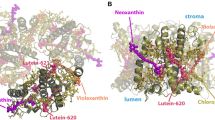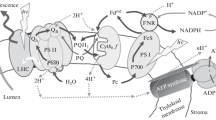Abstract
Several models have been proposed for the energetic behavior of the photosynthetic apparatus and a variety of experimental techniques are nowadays available to determine parameters that can quantify this behavior. The Energy Flux Theory (EFT) developed by Strasser 35 years ago provides a straightforward way to formulate any possible energetic communication between any complex arrangement of interconnected pigment systems and any energy transduction by these systems. We here revisit the EFT, starting from the basic general definitions and equations and presenting applications in formulating the energy distribution in photosystem (PS) II units with variable connectivity, as originally derived, where certain simplifications were adopted. We then proceed to the derivation of equations for a PSII model of higher complexity, which corresponds, from the formalistic point of view, to the later formulated and now broadly accepted exciton–radical-pair model. We also compare the formulations derived with the EFT with those obtained, by different approaches, in the classic papers on energetic connectivity. Moreover, we apply the EFT for the evaluation of the excitation energy distribution between PSII and PSI and the distinction between state transitions and PSII to PSI excitation energy migration. Our analysis demonstrates that the EFT is a powerful approach for the formulation of any possible model, at any complexity level, even of models that may be proposed in the future, with the advantage that any possible energetic communication or energy transduction can be easily formulated mathematically by trivial algebraic equations. Moreover, the biophysical parameters introduced by the EFT and applicable for any possible model can be linked with obtainable experimental signals, provided that the theoretical resolution of the model does not go beyond the experimental resolution.















Similar content being viewed by others
References
Allen JF (1992) How does protein phosphorylation regulate photosynthesis. Trends Biochm Sci 17:12–17
Allen JF (1995) Thylakoid protein phosphorylation, state-1-state-2 transitions, and photosystem stoichiometry adjustment—redox control at multiple levels of gene expression. Physiol Plantarum 93:196–205
Butler WL (1980) Energy transfer between photosystem II units in a connected package model of the photochemical apparatus of photosynthesis. Proc Natl Acad Sci USA 77:4697–4701
Butler WL, Kitajima M (1975) Energy transfer between photosystem II and photosystem I in chloroplasts. Biochim Biophys Acta 396:72–85
Butler WL, Strasser RJ (1977) Tripartite model for the photochemical apparatus of green plant photosynthesis. Proc Natl Acad Sci USA 74:3382–3385
Clayton RK (1966) Relations between photochemistry and fluorescence in cells and extracts of photosynthetic bacteria. Photochem Photobiol 5:807–821
Clayton RK (1967) An analysis of the relations between fluorescence and photochemistry during photosynthesis. J Theor Biol 14:173–186
Cleland RE, Melis A, Neale PJ (1986) Mechanism of photoinhibition: photochemical reaction center inactivation in system II of chloroplast. Photosynth Res 9:79–88
Duysens LNM, Sweers HE (1963) Mechanism of two photochemical reactions in algae as studied by means of fluorescence. In: Japanese Society of Plant Physiologists (ed) Studies on microalgae and photosynthetic bacteria. University of Tokyo Press, Tokyo, pp 353–372
Emerson R, Arnold WA (1932a) A separation of the reactions in photosynthesis by means of intermittent light. J Gen Physiol 15:391–420
Emerson R, Arnold WA (1932b) The photochemical reaction in photosynthesis. J Gen Physiol 16:191–205
Gaffron H, Wohl K (1936) Zur theorie der assimilation. Naturwissenschaften 24:81–90
Genty B, Briantais J-M, Baker NR (1989) The relationship between the quantum yield of photosynthetic electron transport and quenching of chlorophyll fluorescence. Biochim Biophys Acta 990:87–92
Gilmore A, Itoh S, Govindjee (2000) Global spectral-kinetic analysis of room temperature chlorophyll a fluorescence from light harvesting antenna mutants of barley. Phil Trans R Soc Lond B 335:1–14
Govindjee (1995) Sixty-three years since Kautsky: chlorophyll a fluorescence. Aust J Plant Physiol 22:131–160
Hipkins MF (1978) Kinetic analysis of the chlorophyll fluorescence inductions from chloroplasts blocked with 3-(3,4-dichlorophenyl)-1,1-dimethyurea. Biochim Biophys Acta 502:514–523
Joliot A, Joliot P (1964) Etude cinétique de la réaction photochimique libérant l’oxygène au cours de la photosynthèse. CR Acad Sci Paris 258:4622–4625
Kautsky H, Hirsch A (1931) Neue Versuche zur Kohlensäureassimilation. Naturwissenschaften 19:964
Ke B (2001) Photosynthesis: photobiochemistry and photobiophysics. Advances in photosynthesis and respiration (Series ed, Govindjee), vol 10. Kluwer Academic Publishers, Dordrecht
Kitajima M, Butler WL (1975a) Quenching of chlorophyll fluorescence and primary photochemistry in chloroplasts by dibromothymoquinone. Biochim Biophys Acta 376:105–115
Kitajima M, Butler WL (1975b) Excitation spectra for photosystem I and photosystem II in chloroplasts and the spectral characteristics of the distribution of quanta between the two photosystems. Biochim Biophys Acta 408:297–305
Krause GH, Somersalo S, Zumbusch E, Weyers B, Laasch H (1990) On the mechanism of photoinhibition in chloroplasts. Relationship between changes in fluorescence and activity of photosystem II. J Plant Physiol 136:472–479
Lavergne J, Trissl H-W (1995) Theory of fluorescence induction in photosystem II: derivation of analytical expressions in a model including exciton–radical-pair equilibrium and restricted energy transfer between photosynthetic units. Biophys J 68:2474–2492
Ley AC, Butler WL (1977) The distribution of excitation energy between photosystem I and photosystem II in Porphyridium cruentum. In: Miyachi S, Katoh S, Fujita Y, Shibata K (eds) Special edition of plant and cell physiology. Japanese Society of Plant Physiologists, Tokyo, pp 33–46
Lombard F, Strasser RJ (1984) Evidence for spill over changes during state-1 to state-2 transition in green leaves. In: Sybesma C (ed) Advances in photosynthesis research III. Martinus Nijhoff/Dr W Junk Publishers, The Hague, pp 271–274
Melis A, Homann PH (1976) Heterogeneity of the photochemical centers in system II of chloroplasts. Photochem Photobiol 23(5):343–350
Montal M, Darszon A, Strasser RJ (1978) Rhodopsin and bacteriorhodopsin in model membranes. In: Dutton L, Scarper A, Leigh JS (eds) Frontiers in biology energetics, vol 2. Academic Press, New York, pp 1109–1118
Murata N (1969) Control of excitation transfer in photosynthesis. II. Magnesium ion-dependent distribution of excitation energy between two pigment systems in spinach chloroplasts. Biochim Biophys Acta 189:171–181
Paillotin G (1976a) Capture frequency of excitations and energy transfer between photosynthetic units in the photosystem II. J Theor Biol 58:219–235
Paillotin G (1976b) Movement of excitations in the photosynthetic domains of photosystem II. J Theor Biol 58:237–252
Paillotin G (1977) Organization of the photosynthetic pigments and transfer of excitation energy. In: Hall DO, Coombs J, Goodwin TW (eds) Photosynthesis ′77: proceedings of the fourth international congress on photosynthesis. The Biochemical Society, London, pp 33–44
Papageorgiou GC, Govindjee (eds) (2004) Chlorophyll a fluorescence: a signature of photosynthesis. In: Advances in photosynthesis and respiration (Series ed, Govindjee), vol 19. Springer, Dordrecht
Robinson GW (1967) Excitation transfer and trapping in photosynthesis. In: Energy conversion by the photosynthetic apparatus. Brookhaven symposia in biology, number 19. Brookhaven National Laboratory, Upton, pp 16–48
Satoh K, Strasser RJ, Butler WL (1976) A demonstration of energy transfer from photosystem II to photosystem I in chloroplasts. Biochim Biophys Acta 440:337–345
Sorokin EM (1985) The induction curve of chlorophyll a fluorescence in DCMU-treated chloroplasts and its properties. Photobiochem Photobiophys 9:3–19
Stirbet AD, Govindjee Strasser BJ, Strasser RJ (1998) Chlorophyll a fluorescence induction in higher plants: modeling and numerical simulation. J Theor Biol 193:131–151
Strasser BJ, Strasser RJ (1995) Measuring fast fluorescence transients to address environmental questions: the JIP-test. In: Mathis P (ed) Photosynthesis: from light to biosphere, vol 5. Kluwer Academic, The Netherlands, pp 977–980
Strasser RJ (1978) The grouping model of plant photosynthesis. In: Akoyunoglou G, Argyroudi-Akoyunoglou JH (eds) Chloroplast development. Elsevier/North Holland Biomedical Press, Amsterdam, pp 513–524
Strasser RJ (1980) Bacteriorhodopsin and its position in the blue light syndrome. In: Senger H (ed) The blue light syndrome. Springer, Berlin, pp 30–37
Strasser RJ (1981) The grouping model of plant photosynthesis: heterogeneity of photosynthetic units in thylakoids. In: Akoyunoglou G (ed) Photosynthesis III. Structure and molecular organisation of the photosynthetic apparatus. Balaban International Science Services, Philadelphia, pp 727–737
Strasser RJ (1984) The dynamics of the photoreduction of protochlorophyll(ide) into chlorophyll(ide). In: C. Sironval C, Brouers M (eds) Protochlorophyllide reduction and greening. Martinus Nijhoff/Dr W Junk Publishers, The Hague/Boston/Lancaster, pp 317–327
Strasser RJ (1986) Mono-, bi- and polypartite models in photosynthesis. Photosynt Res 10:255–276
Strasser RJ, Butler WL (1976) Energy transfer in the photochemical apparatus of flashed bean leaves. Biochim Biophys Acta 449:412–419
Strasser RJ, Butler WL (1977a) Energy transfer and distribution of excitation energy in the photosynthetic apparatus of spinach chloroplasts. Biochim Biophys Acta 460:230–238
Strasser RJ, Butler WL (1977b) The yield of energy transfer and the spectral distribution of excitation energy in the photochemical apparatus of flashed bean leaves. Biochim Biophys Acta 462:295–306
Strasser RJ, Greppin H (1981) Primary reactions of photochemistry in higher plants. In: Akoyunoglou G (ed) Photosynthesis III. Structure and molecular organisation of the photosynthetic apparatus. Balaban International Science Services, Philadelphia, PA, pp 717–726
Strasser RJ, Tsimilli-Michael M (1998) Activity and heterogeneity of PS II probed in vivo by the chlorophyll a fluorescence rise O-(K)-J-I-P. In: Garab G (ed) Photosynthesis: mechanisms and effects, vol 5. Kluwer Academic Publishers, Dordrecht, pp 4321–4324
Strasser RJ, Srivastava A, Tsimilli-Michael M (2000) The fluorescence transient as a tool to characterize and screen photosynthetic samples. In: Yunus M, Pathre U, Mohanty P (eds) Probing photosynthesis: mechanism, regulation and adaptation. Taylor and Francis, London, pp 443–480
Strasser RJ, Tsimilli-Michael M, Srivastava A (2004) Analysis of the chlorophyll a fluorescence transient. In: Papageorgiou GC, Govindjee (eds) Chlorophyll a fluorescence: a signature of photosynthesis. Advances in photosynthesis and respiration (Series ed, Govindjee) vol 19. Springer, Dordrecht, pp 321–362
Strasser RJ, Tsimilli-Michael M, Qiang S, Goltsev V (2010) Simultaneous in vivo recording of prompt and delayed fluorescence and 820-nm reflection changes during drying and after rehydration of the resurrection plant Haberlea rhodopensis. Biochim Biophys Acta 1797:1313–1326
Tsala G, Strasser RJ (1984) Energy distribution changes during phosphorylation of the light harvesting complex in thylakoids. In: Sybesma C (ed) Advances in photosynthesis research III. Martinus Nijhoff/Dr W Junk Publishers, The Hague, pp 279–282
Tsimilli-Michael M, Strasser RJ (2008) Experimental resolution and theoretical complexity determine the amount of information extractable from the chlorophyll fluorescence transient OJIP. In: Allen JF, Gantt E, Golbeck JH, Osmond B (eds) Photosynthesis. Energy from the sun. Springer, Dordrecht, pp 697–701
Tsimilli-Michael M, Pêcheux M, Strasser RJ (1999) Light and heat stress adaptation of the symbionts of temperate and coral reef foraminifers probed in hospite by the chlorophyll a fluorescence kinetics O-J-I-P. Z Naturforsch 54C:671–680
Vredenberg WJ, Duysens LNM (1963) Transfer of energy from bacteriochlorophyll to a reaction centre during bacterial photosynthesis. Nature (London) 197:355–357
Acknowledgments
M T-M thanks Dr Pierre Haldimann for stimulating discussions, critical comments and valuable suggestions during the preparation of this manuscript.
Author information
Authors and Affiliations
Corresponding author
Rights and permissions
About this article
Cite this article
Tsimilli-Michael, M., Strasser, R.J. The energy flux theory 35 years later: formulations and applications. Photosynth Res 117, 289–320 (2013). https://doi.org/10.1007/s11120-013-9895-1
Received:
Accepted:
Published:
Issue Date:
DOI: https://doi.org/10.1007/s11120-013-9895-1




